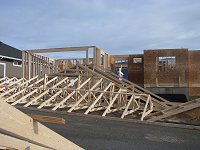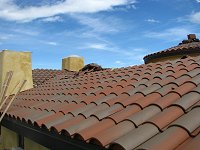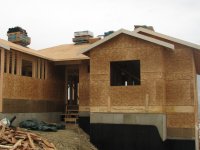Steps Involved in Building a House
Framing

Framing a house refers to the process of constructing the basic structure of a building using wooden or steel beams, columns, and other structural components. This process involves creating a frame or skeleton of the house that will serve as the support structure for the walls, roof, and floors. The frame is typically built according to architectural plans and involves precise measurements and cutting of the structural elements to ensure they fit together correctly. Once the framing is complete, the building can be enclosed with exterior finishes such as siding, roofing, and windows, and the interior walls, floors, and ceilings can be finished to create a livable space. Framing a house is a crucial step in the construction process, as it sets the foundation for the rest of the building and ensures its structural integrity.
During this stage of building, everything seems to go very quickly. It is essential to be organized and know when each trade is required and what they need to complete the job that they have to do. Have you chosen your light fixtures, closet organizers and flooring?
23. Framing

The materials needed for framing should be delivered by the lumber yard. If you are using an engineered flooring system, that should also be on-site when framing starts.
Calculate the number of studs, plates and sheathing material needed: Wall Material Calculator
- Your trusses should have been ordered at this time and scheduled for delivery.
- Once framing starts, establish when the windows and exterior doors should be delivered.
- Apply for a gas meter, especially in wintertime. It could take a bit of time before they come to install it.
- At this time, you should be sure of the layout of your house; discuss any changes with your Framer. Alterations, later on, can be messy and costly. Drop by at the end of the day's work. And do not forget that they are there to make a living. Make sure they can do their job by having the materials on-site when these are needed.
- Be sure to discuss with your Framer the work and materials included in the quote he gave you. For example, supplying nails, framing up sidewalks and the driveway, back framing, etc.
24. Trusses

Trusses and rafters are both structural components used in the construction of roofs. Trusses are pre-fabricated triangular structures made of wood or steel, while rafters are individual beams cut and assembled on-site. Trusses are typically used in modern construction because they are easier and faster to install than rafters and provide better roof support. Conversely, rafters are more traditional and can be used in more complex roof designs. Both trusses and rafters are essential for ensuring the structural integrity of a roof and supporting the weight of the roof materials and any snow or water that may accumulate on top of it.
If trusses in your area are delivered without a boom truck and the framers are ready to place the trusses, you may have to arrange for a crane to be on site. If the plywood for the roof is not onsite, make sure it is here at this time. The crane can place it in a better location.
Note: Too many people working at the same time could create problems. Each trade needs space and time to do a proper job.
Note: Start rough-in plumbing before the Heating because they are more restricted. For instance, a bathtub or toilet drain will have to be precisely where they have to be, and you can be 100% sure that if the heating guy comes first, he will install heating ducts in a run right below one of those drains.

- The cabinet salesperson should come down and mark out the layout of all the cabinets.
- If possible, have large items, such as bathtubs and showers, brought in during framing. If this is impossible, some studs might have to be removed to create enough room for the items to fit through easily.
25. Heating & Plumbing

Heating and plumbing are two essential systems in any building, whether it's a residential or commercial property. Heating systems keep the building warm and comfortable, while plumbing systems ensure a steady supply of clean water and efficient wastewater removal. Heating systems can include furnaces, boilers, heat pumps, or radiant heating systems, and they can be powered by gas, electricity, or oil. Plumbing systems typically consist of pipes, fixtures, and appliances such as sinks, toilets, showers, and water heaters. Proper installation and maintenance of these systems are crucial for the safety and comfort of the building occupants.
You should install roof vents before the roofers go to work.
Note: The Heating & Plumbing Trades have to know where the cabinets are located.
- In general, heat ducting does not require inspections before framing inspection.
- Do make sure after installation that they do not cause annoying squeaks. It is a good plan to find the squeaks now and have them fixed.
- If you are getting a fireplace, don't get one that looks nice; make sure it is an efficient heating unit. Direct vented, glass sealed fireplaces are usually the best.
- In a finished basement, if you are not installing it at this time, a rough-in with pipes and lines required for AC or heat pump is good to include.
26. Roofing

Roofing is essential to any building, as it protects the structure from the elements and helps maintain a comfortable indoor environment. Various roofing materials are available, including asphalt shingles, metal, tile, and slate, each with advantages and disadvantages. The installation process for roofing typically involves laying down a waterproof membrane, followed by the roofing material and any necessary flashing or trim work. Proper roofing installation and maintenance is crucial for ensuring its longevity and effectiveness in protecting the building from weather damage. In addition, regular inspections and repairs can help prevent leaks and other issues that can compromise the integrity of the roof and the building as a whole.

- Roofers will supply roof vents for the ventilation of your attic, and they will able to place them in the spots as required by code. If not, you hired the wrong Roofer!
27. Electrical
Electrical systems are essential to any building, providing power for lighting, appliances, and other electrical devices. These systems typically include a main electrical panel, wiring, outlets, switches, and circuit breakers. Proper installation and maintenance of electrical systems are crucial for safety and functionality. Licensed professionals should install electrical systems and inspect them regularly to ensure they meet safety standards and building codes. It's essential to avoid overloading circuits or using faulty equipment, as this can lead to electrical shocks, fires, and other hazards. Regular maintenance and repairs can prevent these issues and ensure the electrical system operates efficiently and reliably.
Note: The Electrician must know where the cabinets are placed.
Note: Walk through the house with the Electrician and show them where you want all the outlets installed. Think of a place for a Christmas light plug with a switch inside.
- Good quality stove and bathroom fans are a good investment and well worth the extra cost.
- Electricians will install low voltage, cable and telephone wires. If not, contact your phone and cable company to install the necessary wires.
- Even if you are not planning to purchase a satellite disk, running a wire at this time makes a lot of sense.
- Consider pre-wiring for a speaker system.
28. Doors & Windows

After the exterior doors and window installations, you can lock up the house. This is the time you can request your first draw if you have a construction-type mortgage.
Doors and windows are essential for any building, providing access, ventilation, and natural light.
Doors come in various styles, materials, and sizes and can be designed to enhance the aesthetic of the building while providing security and privacy. Common materials for doors include wood, metal, and plastic. They can be equipped with locks, handles, and other hardware to improve functionality and safety. Windows also come in various styles and materials, including wood, vinyl, and aluminum, and can be designed to provide natural light while improving energy efficiency and noise reduction. Proper installation and maintenance of doors and windows are crucial for their longevity and effectiveness in providing access and ventilation while protecting the building from the elements.
- Make sure the window price includes screens, night locks, and liners if desired. It is very frustrating when you do not notice that the excellent price does not include these.
- A very nice alternative to vinyl windows are wood windows. Very classy.
- The exterior doors and windows are delivered at the time the framers are finishing with the roof.
29. Inspections
The trades will most likely call for their respective required inspections, and these should all be done and approved before you call for a framing inspection.
30. Framing Inspection
A framing inspection is a crucial step in the construction process, as it ensures that the building's frame or skeleton is constructed correctly according to architectural plans and building codes. This inspection typically occurs after the framing is complete but before the building is enclosed with exterior finishes such as siding, roofing, and windows. During the inspection, an inspector will check the structural components, such as beams, columns, and joists, to ensure they are the correct size and spacing and are correctly installed. The inspector will also check for defects, such as bowed or twisted framing, and ensure that all necessary fasteners and connectors are used. Any issues found during the framing inspection must be corrected before proceeding with the construction process.
- Although, at times, it may seem that the Inspector's only purpose is to create problems for you, do not ever forget that they are doing a job that concerns the safety and, to some extent, the quality of your home. You have to fix any infractions you get. You will almost always get some, but at least you know that they are doing their job. At times they will have suggestions, and with few exceptions, they will be most helpful.